SONS OF DEWITT COLONY TEXAS
� 1997-2003, Wallace L. McKeehan, All Rights Reserved
New Spain-Index | Philip Nolan-Filibuster | Peter
Ellis Bean
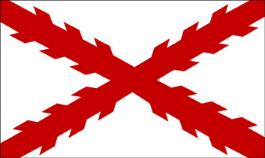 Philip Nolan Site Visit November
1998 Philip Nolan Site Visit November
1998
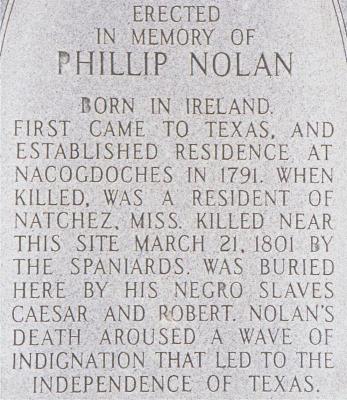 "….a royal order, sent through secret channels, has
arrived ordering the utmost care to prevent the passage to this kingdom of persons from
the United States of America. The king has been informed on good authority that the United
States has ordered emissaries to move here and work to subvert the population…"--Letter
from Royal Commandante Pedro de Nava of the Provincias Internas to Texas governor Manuel
Mu�oz "….a royal order, sent through secret channels, has
arrived ordering the utmost care to prevent the passage to this kingdom of persons from
the United States of America. The king has been informed on good authority that the United
States has ordered emissaries to move here and work to subvert the population…"--Letter
from Royal Commandante Pedro de Nava of the Provincias Internas to Texas governor Manuel
Mu�oz
From his headquarters in Chihuahua in 1796, Commandante de Nava issued
orders banning foreigners entrance into Texas without extensive documentation, including
citizens of Louisiana, targeting particularly the Anglo-Americans. At this height of
Spanish xenophobia regarding individuals from the newly independent Confederation of
American States to the north entered "bold pathfinder, reckless mustanger,
conniving entrepreneur, passionate adventurer, betrayed filibuster, martyred freedom
fighter" Philip Nolan, born in Belfast, Ireland in 1771 and a resident of
Kentucky in 1789. Despite his awareness of the suspicions of both governor Manuel Gayoso
de Lemos in Natchez, governor Mu�oz of Texas and Commandante de Nava that he was a spy
for either the new Confederation or for conspirators with designs for separation of
territories from Spain, Nolan entered Texas in fall 1800 with 27 associates (18 Americans,
7 Spaniards and 2 Negro slaves) and traveled from Natchez up the Mississippi River to
current Vicksburg then turned west toward Texas via an unusually northern route for
explorers of the period. After crossing the Ouachita, Red, Sabine, Neches and Trinity
Rivers, the party built a corralling station and a primitive fort (called Nolan's Fort) on
the current Nolan River near the Brazos River. Under orders from Texas Governor Juan
Bautista de Elguezabal authorized commander Manuel M�zquiz at Nacogdoches to arrest
Nolan. M�zquiz and his patrol of 120 royal soldiers encountered Nolan and associates on
21 March 1801 near current Blum in Hill County, Texas. In the confrontation that followed,
a ball killed Nolan, and his men surrendered under a white flag raised by the king's men
and promise of safe return to the United States.
The purpose of Nolan's mission is a historical controversy. His loyal
associates who were captured, taken to prison in San Antonio, then Chihuahua and other
sites maintained it was simply a mission to capture mustangs for sale back east similar to
those previously carried out by Nolan with clear permission of the government. In
Chihuahua, eight of the loyal Nolan associates were forced to roll dice, the lowest number
of which was to be executed for resisting the king’s soldiers. Ephraim Blackburn
rolled a four and was hanged in 1807. The others died in Spanish prisons except the
remarkable Peter Ellis Bean, who rolled a five in the cast of the die. Traitorous
associates, possibly under duress or to please authorities, contended Nolan was overtly
mapping the countryside and boasted of eventually taking the country and its treasures
from Spain. Others contend he was directly or indirectly an agent of the Jefferson
government. Similar to Alamo heroes like Crockett, Bowie and Travis, at times Nolan has
been elevated to hero and martyr status as one of the earliest to test the inability of
Spain (later Mexico) to hold and develop the untamed territory of Texas into a viable
Republic. Others see him as strictly an early filibuster who was trespassing on Spanish
territory in a commercial venture without proper papers, a status of which some also view
Crockett, Travis and other illegal immigrants into Mexican Texas.
Authors Maurine Wilson and Jack Jackson in Philip Nolan and Texas:
Expeditions to the Unknown Land 1791-1801:
Simply stated, the truth about Nolan is as much a mystery today as it
was when he perished in the Texas wilderness over eighteen decades ago. Perhaps we will
never know what drove him to his tragic destiny, but the need to know seems destined to
persist. Philip Nolan - bold pathfinder, reckless mustanger, conniving entrepreneur,
passionate adventurer, betrayed filibuster, martyred freedom fighter - lives on in the
American consciousness, in fact and in fiction. As always, the distinction between the two
rests enshrouded in an unknown grave, protected by Los Brazos de Dios.
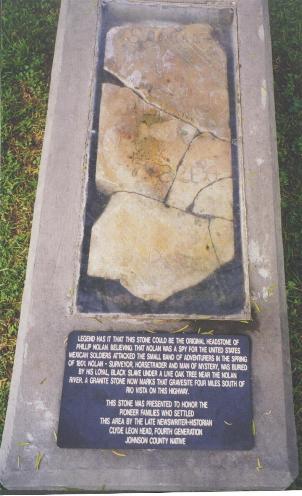 On a beautiful post-Thanksgiving Friday morning 1998 three McKeehan brothers
of Houston and Ft. Worth departed Ft. Worth to locate and get the feel of where these
historic events occurred. Meandering through the scenic route using our trusty Texas
A&M's The Roads of Texas we arrived in the
village of Rio Vista which is four miles north of first of the two putative sites where
Nolan was struck down and his associates captured that spring day of 1801 on the current
Nolan River. Rio Vista's old town consists of not more than three older buildings and its
new town largely a few modern businesses clustered around the Cow Pasture Bank. Next to
the bank building is a small park where a mid-19th century settler's cabin has been
preserved and placed the period in which settlement of this area finally began to
significantly occur. Encased in glass and stone shaded by a mesquite tree, covered with
golden fallen mesquite leaves and guarded by fire ant beds was the stone marker shown
below which is thought to have been an original marker at the site where Nolan was buried
by his two servants, Robert and Caesar. The crudely carved "Sacred to the Memory of
Nolan" is visible on the old stone as well as assorted other markings, all of which
could be historic graffiti before the stone was encased. At the same location is another
state historical highway marker noting the site of the Menafee Reunion, a few miles
southwest on the Nolan River, which was hosted beginning in the late 19th century by
descendants of the pioneering William Menafee family of the DeWitt Colony area and current
Jackson and Fayette counties. This site is worth a side trip and contains another
old settler’s cabin, what appears to be a meeting house in disrepair and probably the
oldest cemetery of the area, replete with armadillo burrows and diggings, containing sites
of mid-19th century pioneers. The fact that this country was an uninhabited wilderness
until the mid-19th century except for nomadic aborigines as the Mexican colonies of
Austin, DeWitt and others were being settled in the late 1820’s and early 1830’s
emphasizes the uniqueness of adventurers like the Nolan band who ventured into this area. On a beautiful post-Thanksgiving Friday morning 1998 three McKeehan brothers
of Houston and Ft. Worth departed Ft. Worth to locate and get the feel of where these
historic events occurred. Meandering through the scenic route using our trusty Texas
A&M's The Roads of Texas we arrived in the
village of Rio Vista which is four miles north of first of the two putative sites where
Nolan was struck down and his associates captured that spring day of 1801 on the current
Nolan River. Rio Vista's old town consists of not more than three older buildings and its
new town largely a few modern businesses clustered around the Cow Pasture Bank. Next to
the bank building is a small park where a mid-19th century settler's cabin has been
preserved and placed the period in which settlement of this area finally began to
significantly occur. Encased in glass and stone shaded by a mesquite tree, covered with
golden fallen mesquite leaves and guarded by fire ant beds was the stone marker shown
below which is thought to have been an original marker at the site where Nolan was buried
by his two servants, Robert and Caesar. The crudely carved "Sacred to the Memory of
Nolan" is visible on the old stone as well as assorted other markings, all of which
could be historic graffiti before the stone was encased. At the same location is another
state historical highway marker noting the site of the Menafee Reunion, a few miles
southwest on the Nolan River, which was hosted beginning in the late 19th century by
descendants of the pioneering William Menafee family of the DeWitt Colony area and current
Jackson and Fayette counties. This site is worth a side trip and contains another
old settler’s cabin, what appears to be a meeting house in disrepair and probably the
oldest cemetery of the area, replete with armadillo burrows and diggings, containing sites
of mid-19th century pioneers. The fact that this country was an uninhabited wilderness
until the mid-19th century except for nomadic aborigines as the Mexican colonies of
Austin, DeWitt and others were being settled in the late 1820’s and early 1830’s
emphasizes the uniqueness of adventurers like the Nolan band who ventured into this area.
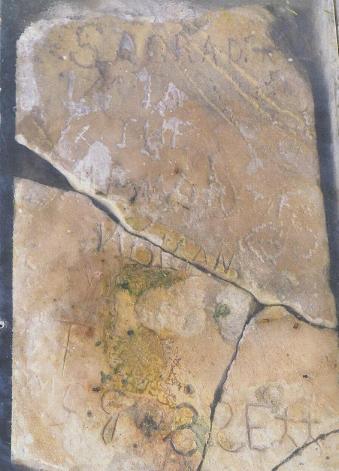
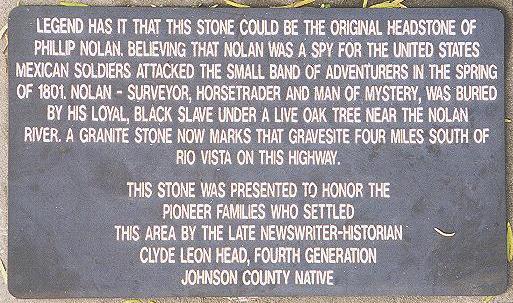
Photos: Top, top half of the Nolan marker at Rio Vista,
possibly an early stone placed at the gravesite of Nolan where he was buried by servants,
but thought by others to be a hoax. The words "Sacred to the Memory of
Nolan" with date 1843 are visibly scrawled on the stone. Bottom,
bottom part of the marker at Rio Vista, the marker erroneously refers to the Spanish royal
forces from Nacogdoches as Mexican soldiers.
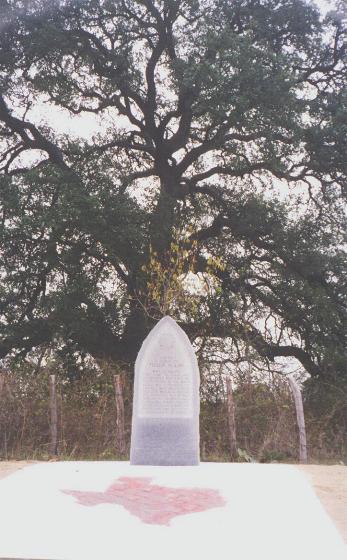 Returning to Highway 174 at Rio Vista we continued southeast to one
of the areas where most believe Nolan’s band confronted the Spanish king's men, where
Nolan was struck dead and buried and the rest of the band surrendered. Just up from the
river bridge is the main Nolan Historical Marker placed privately in 1954 and behind it is
a majestic liveoak tree which makes one want to believe the setting was indeed similar to
descriptions of where the faithful servants buried Nolan’s body after his ears were
cut off for presentation to the governor and commandante general by Nolan business
competitor and interpreter for the royal patrol, William Barr, of Barr and Davenport. The
site has recently been improved by a culvert to divert water between the marker and the
road and placement of an attractive concrete viewing platform inlaid with red brick the
shape of Texas. This attests to the increasing interest in preservation of local historic
sites and the rumor that current Gov. Bush listens. Returning to Highway 174 at Rio Vista we continued southeast to one
of the areas where most believe Nolan’s band confronted the Spanish king's men, where
Nolan was struck dead and buried and the rest of the band surrendered. Just up from the
river bridge is the main Nolan Historical Marker placed privately in 1954 and behind it is
a majestic liveoak tree which makes one want to believe the setting was indeed similar to
descriptions of where the faithful servants buried Nolan’s body after his ears were
cut off for presentation to the governor and commandante general by Nolan business
competitor and interpreter for the royal patrol, William Barr, of Barr and Davenport. The
site has recently been improved by a culvert to divert water between the marker and the
road and placement of an attractive concrete viewing platform inlaid with red brick the
shape of Texas. This attests to the increasing interest in preservation of local historic
sites and the rumor that current Gov. Bush listens.
Just a few hundred yards down the road from the marker is the Nolan
River (photo below) making its way to the Brazos de Dios further south. The
scene was probably not as colorful at the time of year the spot was visited by Nolan and
his men. Today the staccato thump and vibration of the occasional auto on the
bridge disrupted the beautiful and serene view as did the mixture of shouts in Irish and
southern Creole English and Creole and Castillian Spanish interspersed with musket fire
almost 200 years earlier. Although still relatively clear water runs through the
limestone bed of the river, called only a creek by some records, the river was likely a
pristine and welcome source of water for Nolan's men, his captured mustangs and the royal
Spanish patrols moving through the area.
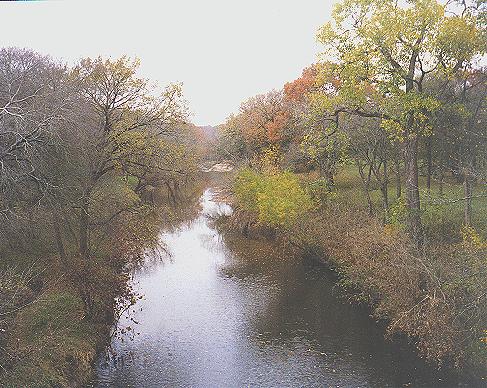
As for most historic events, there is disagreement regarding the site
of Nolan’s death and the current marker has a history of its own. From Wilson
and Jackson in Philip Nolan and Texas:
An interesting chain of events
lies behind this marker, to an extent involving Miss Wilson [co-author and for many
years member of the University of Texas Archives Library Staff]. In 1949 she received
a letter from the Rev. Rhea Kuykendall, a descendant of one Joseph Pierce who had settled
on the "old Dixon Grant" along Mustang Creek, a branch of Nolan River.
Kuykendall, in visiting his ancestor's gravesite, had discovered a weathered
tombstone," on which appeared in dots the words 'Sacred to the Memory of
Nolan'," with the date 1843 scratched in below. Since a new state highway (174) was
about to be built and "will pass in 12 feet of Nolan's grave," Kuykendall
appealed to Miss Wilson for help in obtaining a historical marker from the Highway
Commission, not having any luck at convincing historic site expert L. W. Kemp that he had
found the correct spot. Nothing came of the Reverend's appeal and Highway 174 was built,
40 feet from the oak tree that towers above what he thought to be
Nolan's final resting place.
A few years later, Clyde Head, a
young reporter for the Cleburne Times-Review, also stumbled upon Nolan's tombstone and
wrote an article about it for his newspaper. The article stirred considerable interest.
Mr. Head wisely removed for safekeeping the "homemade sandstone
marker," already broken by vandals into three pieces. In 1954 Eric Adams, owner
of Modern Monument Works of Cleburne, donated and erected at his own expense a one-ton
monument of Georgia granite on the site. A noted Cleburne attorney, Finis Johnson, wrote
the inscription that Adams chiseled into stone. According to Mr.
Head, when Eric Adams drank a cup of coffee he never went to the trouble of removing a big
chew of 'White Tag Tinsley'." Thus did proud Texans, acting without the state's
official sanction, bring to germination the tribute that Jos� Agust�n Quintero
had suggested for Nolan in 1868. [Quintero suggested a
memorial should be placed for Nolan with the wording SISTE, VIATOR, HEROEM CALCUS
(Pause, oh traveler, for thou art treading upon heroic soil)].
Ironically, the sandstone marker
that inspired Adams' monument seems to have been a hoax. Lynn Bellah, a long-time Nolan
enthusiast, says that he knows the men who fashioned this marker and put it under the oak
tree for the benefit of "would-be fortune-finders." Mr. Bellah's investigations
have placed Nolan's fort and battle field near Carmichael Hill, just over a mile southwest
of Blum (east of Nolan River), not between Blum and Rio Vista, where the monument is
located.
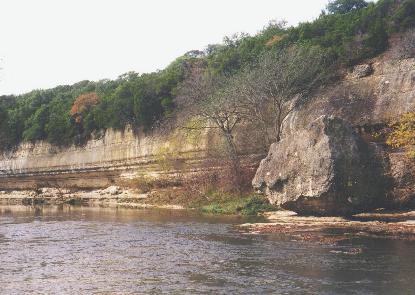 This second site (arrow on the map) described by Bellah is
near current Blum in Hill County near an S-shaped double bend in the river nearer its
entry into the Brazos, however, there appear no access roads to this actual site. We
continued down Highway 174 exiting on County Road 933 which again crosses the Nolan River
just before the community of Blum to get as near this site as possible. At this crossing
of the river (photo left) are picturesque limestone banks on one side of
the river probably cut out over over eons and allows one to imagine that near such
structures was the ravine-like formations described by Peter Ellis Bean in his memoirs in
which the Nolan force took refuge to make a stand against the royal patrol after loss of
leader Nolan and prior to their surrender. At this point the shallow river running
over the rock bed (photo below) was probably utilized as a crossing for the
adventurers 200 years ago as it is today used by sufficiently rugged off-the-road vehicles
who apparently ignore the "No Trespassing" signs just as Nolan's party ignored
the "No Trespassing" warnings of the royal Spanish government. This second site (arrow on the map) described by Bellah is
near current Blum in Hill County near an S-shaped double bend in the river nearer its
entry into the Brazos, however, there appear no access roads to this actual site. We
continued down Highway 174 exiting on County Road 933 which again crosses the Nolan River
just before the community of Blum to get as near this site as possible. At this crossing
of the river (photo left) are picturesque limestone banks on one side of
the river probably cut out over over eons and allows one to imagine that near such
structures was the ravine-like formations described by Peter Ellis Bean in his memoirs in
which the Nolan force took refuge to make a stand against the royal patrol after loss of
leader Nolan and prior to their surrender. At this point the shallow river running
over the rock bed (photo below) was probably utilized as a crossing for the
adventurers 200 years ago as it is today used by sufficiently rugged off-the-road vehicles
who apparently ignore the "No Trespassing" signs just as Nolan's party ignored
the "No Trespassing" warnings of the royal Spanish government.
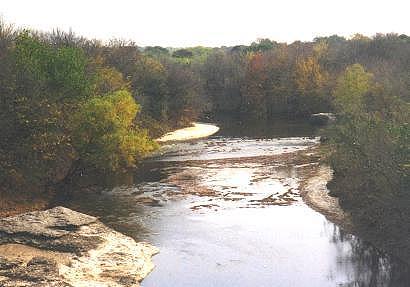 After once again reliving the exciting scene of 200 years ago in
our minds, we returned to Blum where we dined on cheeseburgers and french fries at Fat
Albert’s, one of the two gas stations with a grill in the village, with thoughts that
the burgers were probably not that large of a contrast to the campfire-roasted mustang and
venison eaten by Nolan and his men possibly on the same spot. As we continued home to
leftover Thanksgiving fixings and fear of potential consequences of the poorly inflated
left rear tire on the rental car and our near empty gas gauge, we admired the apparent
fearlessness of Philip Nolan, Peter Ellis Bean
and other loyal associates in the unknown land of 200 years ago whose long and, except for
Bean, disastrous imprisonment was just beginning as they were accompanied to Nacogdoches,
then San Antonio, Chihuahua and points south having surrendered under the guise of the
white flag and promise of return to the US of the North. After nearly 15 years
imprisonment, witnessing the death of his colleagues in Spanish dungeons, numerous escape
attempts and vacillation between minimum and maximum security, the stranger than fiction
life of Peter Ellis Bean included release and service to the royal anti-insurgent forces,
desertion to the Mexican insurgent forces of Jos� Morelos, appointment to Colonel in the
Mexican army, marriage to Creole royalty, return to Tennessee and marriage and a family,
return to Texas and eventual return to Jalapa where he died just before Texas became a
state of the United States of the North. After once again reliving the exciting scene of 200 years ago in
our minds, we returned to Blum where we dined on cheeseburgers and french fries at Fat
Albert’s, one of the two gas stations with a grill in the village, with thoughts that
the burgers were probably not that large of a contrast to the campfire-roasted mustang and
venison eaten by Nolan and his men possibly on the same spot. As we continued home to
leftover Thanksgiving fixings and fear of potential consequences of the poorly inflated
left rear tire on the rental car and our near empty gas gauge, we admired the apparent
fearlessness of Philip Nolan, Peter Ellis Bean
and other loyal associates in the unknown land of 200 years ago whose long and, except for
Bean, disastrous imprisonment was just beginning as they were accompanied to Nacogdoches,
then San Antonio, Chihuahua and points south having surrendered under the guise of the
white flag and promise of return to the US of the North. After nearly 15 years
imprisonment, witnessing the death of his colleagues in Spanish dungeons, numerous escape
attempts and vacillation between minimum and maximum security, the stranger than fiction
life of Peter Ellis Bean included release and service to the royal anti-insurgent forces,
desertion to the Mexican insurgent forces of Jos� Morelos, appointment to Colonel in the
Mexican army, marriage to Creole royalty, return to Tennessee and marriage and a family,
return to Texas and eventual return to Jalapa where he died just before Texas became a
state of the United States of the North.
For more Texian Web Site Visit Reports, see:
Ft. Teran Site Visit July 1998 by W.L.
McKeehan
A Trip to Ft. Lipantitlan by Charles
Yates
In Search of Creed Taylor by Charles
Yates
New Spain-Index | Philip Nolan-Filibuster | Peter
Ellis Bean
SONS OF DEWITT COLONY
TEXAS
� 1997-2003, Wallace L. McKeehan, All Rights Reserved |






 This second site
This second site  After once again reliving the exciting scene of 200 years ago in
our minds, we returned to Blum where we dined on cheeseburgers and french fries at Fat
Albert’s, one of the two gas stations with a grill in the village, with thoughts that
the burgers were probably not that large of a contrast to the campfire-roasted mustang and
venison eaten by Nolan and his men possibly on the same spot. As we continued home to
leftover Thanksgiving fixings and fear of potential consequences of the poorly inflated
left rear tire on the rental car and our near empty gas gauge, we admired the apparent
fearlessness of Philip Nolan,
After once again reliving the exciting scene of 200 years ago in
our minds, we returned to Blum where we dined on cheeseburgers and french fries at Fat
Albert’s, one of the two gas stations with a grill in the village, with thoughts that
the burgers were probably not that large of a contrast to the campfire-roasted mustang and
venison eaten by Nolan and his men possibly on the same spot. As we continued home to
leftover Thanksgiving fixings and fear of potential consequences of the poorly inflated
left rear tire on the rental car and our near empty gas gauge, we admired the apparent
fearlessness of Philip Nolan,